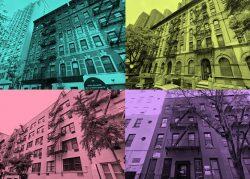Two property deals recorded this week showcase a stark divide between Manhattan’s disparate ends. Downtown, the market for investment sales is rapidly heating up; Uptown, it’s stagnating.
Shel Capital and Bluestone Investments’ $51.5 million acquisition of a four-building portfolio in the East Village is evidence of the former.
The buildings, located off Second Avenue between East Fifth and East 12th streets, traded at an average price per square foot of $640. John J. Stewart and Dylan Torey of Marcus & Millichap represented both the buyer and seller. The price was in line with the third-quarter average for multifamily properties, according to Avison Young’s market report, but still down 12 percent from this time last year.
The discount, coupled with the improving state of the rental market, is a recipe for profit.
“Assuming [the buyers] do nothing and just re-rent the units, you’re going to see, because of the demand to live in this neighborhood, there’s a pop,” said Brandon Polakoff, principal and executive director of Avison Young’s Tri-State Investment Sales Group, who analyzed the deal.
The portfolio, which contains 125 units, is mostly free-market units, according to public tax records. As renters have flocked back to New York, a surge in demand and declining inventory have driven up asking rents. Zumper reported the city had surpassed San Francisco as the most expensive place to rent nationally in August. In November, the price of a New York one-bedroom was nearly a quarter higher than the previous year.
Polakoff said that’s what investors are banking on.
“They’re saying to themselves, ‘Okay, I see that in the East Village today for a really gorgeously renovated one-bedroom they’re getting $1,900 a month, [but] I can rent that for $3,500 a month,’” he said.
Read more

The Avison Young executive said inflation has also driven rents higher and investors expect the trend to continue.
“It’s funny, nothing’s really changed about the buildings between now and a year ago. The only thing that’s changed is the confidence level,” Polakoff said. “Buyers are ultimately purchasing something based on the assumptions they’re making about the future.”
Rony Kravel, principal of Shel Capital, the East Village portfolio buyer, said in an email that the purchase reflects the firm’s confidence in the city’s comeback.
“We are big believers in New York,” Kravel said. “Nobody can argue that the resilience the city has shown post-Covid is less than remarkable.”
PincusCo first reported the deal; Adrian Slywotzky was the seller.
Polakoff said that Slywotzky, a Massachusetts-based, multi-generational owner who assumed control of the portfolio after the family’s patriarch and matriarch died, is likely more interested in cashing out than the work of managing. Slywotzky did not return a request for comment.
“Covid, I think it kind of humbled a lot of people,” Polakoff said, noting that some sellers he’s worked with have taken a step back during the pandemic and decided that the time it takes to manage a building would be better spent elsewhere.
Uptown, investment sales tell a much different story.
Avison Young’s report showed an 83 percent increase among multifamily and mixed-use deals in Manhattan in the third quarter. All of the trades completed in August and September took place south of 96th Street, according to a visualization.
In Washington Heights, Harlem and the Bronx — the borough was not included in Avison Young’s analysis — buildings tend to be heavily rent-stabilized. Since the 2019 Housing Stability and Tenant Protection Act snuffed out nearly all avenues to raise the rents on regulated units, Polakoff said there’s not much upside to those properties.
“When someone’s buying those buildings, it’s more so a cash-flow position,” he said. The buildings are significantly cheaper and rents from stabilized tenants are usually dependable. But the possibility for bigger returns isn’t there.
Take 1965 Lafayette Avenue in the Bronx, which Yechiel Newhouse just bought for $43 million from PL Preservation, an entity affiliated with Pembroke Residential Holdings, according to public records. Ariel Property Advisors President Shimon Shkury and Executive Vice President Victor Sozio represented the seller in the deal, a spokesperson for the firm said.
The building is entirely rent-stabilized, tax records show. With over 400,000 square feet, according to Property Shark, the property traded at a measly $107 per square foot.
Polakoff said the upside for Newhouse, who did not return a request for comment, could be economies of scale: Investors buying in Upper Manhattan and the Bronx may already have property managers in the area.
Newhouse has picked up at least 34 rent-stabilized buildings in those neighborhoods since the rent law passed. In April, he nabbed 1240 Morrison Avenue for $24 million, the Commercial Observer reported. The building is 90 percent rent-stabilized, according to tax records, and, like 1965 Lafayette, is in Soundview.
The recent acquisition has also benefited from a substantial renovation in recent years. A spokesperson for the seller, PL Preservation, said it acquired the building in 2018 to preserve the property as affordable housing. The purchase was part of a public-private partnership with NYC Partnership Housing Development Fund, a nonprofit committed to preserving affordable housing.
The spokesperson said PL Preservation had invested about $10 million in capital improvements and sold 1965 Lafayette because it wanted to turn its attention to additional affordable projects.
For Newhouse, the acquisition looks to be a straightforward way to pull in rent.
“Uptown, pretty much what you’re buying is what you’re getting,” Polakoff said. “You’re focused on trying to limit expense and maintain your rent roll and collections.”